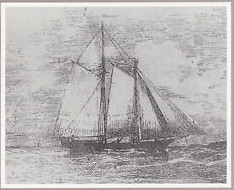CSS
Spray: The Scourge of the Florida Blockaders
Operating
out of the Confederate Naval Station at St. Mark's, Florida, the CSS
Spray was a thorn in the side of the Yankee blockaders who
operated along the west and northern Gulf Coasts of Florida. From
1863 when this valiant ship was added to the Confederate fleet, until
her surrender in 1865, the CSS Spray played havoc with the
East Gulf Blockading Squadron of the US Navy. The CSS Spray would
serve exclusively in Florida waters during her career in the
Confederate Navy, but was very ably commanded and very much up to the
task of giving the Yankees pure hell when it came to disrupting their
plans and keeping Florida in the war on the Confederate side.
Lt.
Charles W. Hays was the first commander of this stout little vessel
and he handily outfitted the ship and utilized it to keep the Yankee
blockaders clear of Appalachicola Bay. Lieutenant Hays also managed
to thwart an attempted sortie up the Chattahoochee River by the
USS Stars and Stripes that was aimed at harassing Tallahassee and
disrupting the Confederate Naval Arsenal at Columbus, Georgia.
Through his capable leadership, Lt. Hays kept the Yankees at bay
throughout 1863.
In
1864, Lt. Hays relinquished command of the CSS Spray and moved
to another assignment within the Confederate Navy. Lt. Henry L. Lewis
took command of the ship and would remain her commander until the end
of hostilities in 1865. Lt. Lewis was born in Virginia and prior to
the war had joined the US Navy. He had also commanded the CSS
Rappahannock before being assigned to command the CSS Spray.
In
February of 1864, Lt. Lewis and his brave crew aboard the CSS
Spray thoroughly surprised an attempt by a Federal armada of 14
ships to destroy the ammunition foundry at Newport, Florida. The
Federal armada had landed two expeditionary forces of US Marines and
sailors with orders to proceed to Port Leon, Florida and capture and
destroy Fort Ward there that protected the Ochlockonee Bay from
Yankee invaders. In the action that ensued, Lt. Lewis and his men
were able to draw most of the Yankee armada away from the Florida
coast and out into the Gulf. As they did this, Confederate land
forces were able to mount seriously coordinated resistance to the US
Marine expeditionary forces and force the Yankees to leave the area.
This coordinated effort by Confederate forces would keep St. Mark's,
Florida open as a blockade running port throughout the war and would
come together later in 1865 to thwart yet another Yankee invasion of
the region.
In
March 1865, the Yankees under Gen. John Newton would again attempt to
destroy Fort Ward and would be met by a coordinated Confederate Navy
and Army effort that destroyed the Yankee forces at the Battle of
Natural Bridge. At the Battle of Natural Bridge, the CSS Spray
would prove her worth to the Confederate cause as a river-borne
attack battery of artillery. Because the Spray was able to shell the
Yankees as they moved positions throughout the battle, the ragtag
Confederate Army forces of invalids and local home guard militia were
able to thoroughly rout the US forces trying to make their way to
take Ft. Ward. Although the war was to end within just a few weeks,
the CSS Spray proved itself to be a continual thorn in the
side of the Yankee invaders who attempted to take Tallahassee and
subjugate it under the Federal boot.
The
post-war fate of the CSS Spray is rather unknown. Some stories
say that Lt. Lewis and the brave crew scuttled the ship on the
northern reaches of the Chattahoochee River rather than witness their
brave ship be surrendered to the Yankee invaders. Other stories tell
that the CSS Spray returned to civilian life after the war as
an intracoastal commerce trading vessel that plied the waters of
western Florida until some time in the early 20th Century.
Regardless of what happened to the ship, the men who crewed her and
the able commanders who led them certainly lived up to the honor of
the Confederate Navy and proved to be a continual scourge to the US
Navy's East Gulf Blocading Fleet throughout the war.
Sources
“CSS
Spray,”
Wikipedia
“The
Spray,” Little Town Mart
“CSS
Spray,” 290 Foundation

